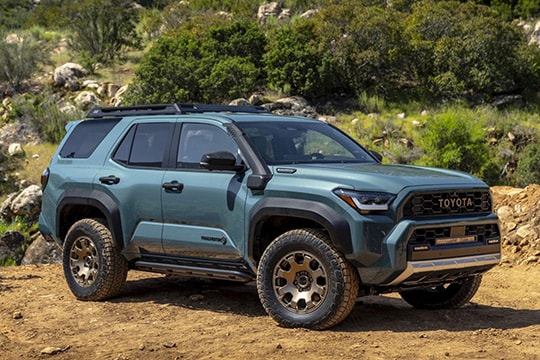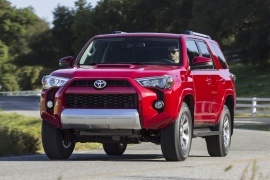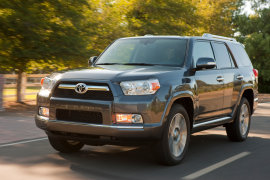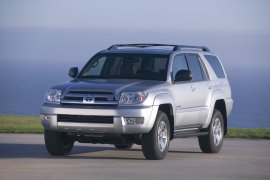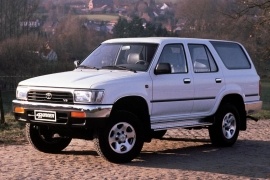TOYOTA 4Runner Models/Series Timeline, Specifications & Photos
First production year: 1990
Engines: Gasoline, Diesel
Body style: SUV (Sports Utility Vehicle)
Toyota introduced the sixth generation of the 4Runner in the spring of 2024, ending the 15-year-long career of its predecessor, and the new model was a revolution in the model’s history.
The Japanese automaker introduced the 4Runner in 1983 for the 1984 model year, and by 2024, it sold over 4 million units. By the time the sixth generation was launched, this nameplate was already iconic in Toyota’s inventory. This SUV was one of the best options for those looking for remote places to camp, school runs, and daily drivers. Moreover, its ability to climb over rocks and endure harsh environments transformed it into a vehicle highly appreciated in off-road communities. For the 2025 model year, the 4Runner came with modern styling, a comfortable interior, fuel-efficient engines, and was packed with technologies. The automaker redesigned it from the ground up and built it on the same TNGA-F platform shared with its siblings, the Tacoma, the Land Cruiser, the Tundra, and the Sequoia.
Toyota’s design team followed the concept of the original 4Runner when it penned it but modernized it. As a result, the front fascia featured horizontal LED headlights and raised outer edges. They integrated the daytime running lights and flanked an angular-shaped main grille that sported the Toyota name or the chromed badge of the automaker, depending on the grade. The bumper integrated a lower air intake underlined by a rock slider shield and an apron.
From its profile, the SUV’s rugged appearance was emphasized by flared wheel arches with angular styling. The TRD Pro version featured additional black plastic moldings. Also, depending on the trim level, the 2025 4Runner featured body-colored or black door mirror caps and handles. A set of side steps adorned the sills below the sculptured doors. For the rear quarter panels, Toyota created taller shoulders, echoing the design of the 4Runner’s first generation. Another specific design element was for the raked-forward C-pillars behind the rear doors. Finally, at the back, the rear window could roll down into the tailgate, like on its predecessor.
The cabin welcomed its occupants with a modern interior. Atop the center stack, Toyota placed an eight-inch or a ten-inch touchscreen for the infotainment system, depending on the option. At the same time, in front of the driver was the instrument cluster that housed a seven-inch digital display, while the higher grades featured a 12.3-inch one. A four-spoke steering wheel resembled the one from the previous generation of the 4Runner. Between the front occupants, the automaker placed a center console. It housed the buttons and controls for the transmission, the available 4x4 commands, and a pair of cup holders. Depending on the grade, Toyota installed bucket seats wrapped in fabric or a mix of Alcantara and artificial leather. At the same time, in the back, the automaker installed a split-folding (60/40) bench seat.
The automaker tried to keep its customers safe, so it installed the Toyota Safety Sense 3.0 system, which integrated lane-keep, assist, adaptive cruise control, automatic emergency braking, blind-spot monitor, and others. Under the 4Runner’s hood, the car manufacturer installed a turbocharged inline-four engine, with or without a hybrid system. Toyota offered the 4Runner with a choice of three drivetrains that could send the power to the rear wheels only via an all-wheel drive system or a rugged part-time 4WD.
Toyota introduced the fourth generation of the 4Runner truck-based SUV on the market in 2009, and four years later, it upgraded it for the 2014 model year with a substantial facelift.
While most other competitors started to morph their SUVs from body-on-frame to monocoque solutions, Toyota kept its 4Runner lineup based on a sturdy ladder-frame chassis for competent off-road situations. But that didn’t mean it was like a utility vehicle on the interior. It was just a rugged, seven-seat family car that could take everybody, and a trailer attached behind, to remote areas and bring them back to cities. Moreover, the automaker kept things civilized and user-friendly.
The rugged look of the 4Runner’s fourth generation made many people fall in love with it. Despite struggling with the world financial crisis from 2008-2010, the vehicle’s sales started to bounce back again. Toyota made some changes to the exterior, where the 4Runner got a new grille with chromed surroundings for the Limited trim level. The headlights kept their shapes but got projector beams instead of regular halogen lamps for the entire range. In addition, the taillights were fitted with LEDs.
Toyota offered the 2014 4Runner in three trim levels: SR5, Trail, and Limited, and the middle grade was the only one that didn’t receive the seven-seat option. On the dashboard, the first two levels could be optioned with a 6.5” infotainment unit running Toyota’s Entune system that featured GPS navigation. This was standard for the Limited trim level and offered as an option for the SR5 and Trail. This system allowed for music streaming via Bluetooth from mobile phones.
The wide, rugged dials for the climate control unit and other buttons allowed customers to use them with gloves on. Fronting the driver was a new instrument cluster with backlit illumination named Optitron. The automaker kept the same seating formula as on the non-facelifted model, with higher front seats and a lower-mounted middle row. The third row, when optioned, was in the trunk and was mostly for kids. With all the seats up, the trunk offered just 9 cu-ft (255 liters) of space, but with the third row folded down, there were 46.3 cu-ft (1,311 liters) available. By keeping just the front seats in place, the 4Runner morphed into a small utility vehicle with a total capacity of 89.5 cu-ft (2,534 liters) of luggage space.
The 2014 model year was available with just one engine, the four-liter V6 powerplant that was offered as an option on the previous model. Its power was sent to the rear or in all corners via a five-speed automatic transmission. Toyota offered the SR5 with standard rear-wheel-drive but included the part-time 4WD as an option.
For the Trail grade, this system was standard, and for the Limited, Toyota installed a full-time all-wheel-drive at no extra cost. Thanks to the independent, double-wishbone front suspension and the five-link axle in the back, the 4Runner was comfy, and it used gas-filled shock absorbers and coil springs in all corners.
Toyota introduced the fifth generation of the 4Runner in 2009, and it was already a known, trustworthy SUV desired by those who didn't want to go chasing animals through the forests.
With a vast off-road experience, Toyota had it's saying on the SUV market, especially on the mid-size segment where the 4Runner sat. Even though it was introduced as a less-utilitarian version for the HiLux, it became a closed-body vehicle with four doors and a tailgate. Moreover, it was also available with a 2WD system. But for the off-road enthusiasts, the carmaker offered a Trail version, which was more capable with a low-range gear and rear locking differential. After all, it was based on the same FJ-Cruiser ladder-chassis.
The exterior design was more of an improvement over the fourth generation. Its blacked-out grille and prominent, angular headlights made the car looks business. The flared fenders were already a styling signature for the 4Runner, and the customers required that. Behind the four doors with black grab-handles, the carmaker added a raked-forward third window. At the back, a roof spoiler adorned the top of the tailgate.
Inside, the 4Runner shared some of the ideas found in the Lexus GX460. Its beefy controls from the center stack were made to be operated with gloves on. Its triple-pad layout in the instrument panel looked sporty, with the speedometer in the middle, the tachometer on the left, and three gauges on the right sharing the same dial. In the back, the carmaker installed a 60/40 split-bench where three adults could fit well. A third-row sitting bench was optional. With all the seats down, the 4Runner offered 2,548 liters (90 cu-ft) of space, while with all seats in place provided (1,217 liters) 43 cu-ft.
The fourth generation of the Toyota 4Runner was introduced in 2002 and it followed the basic principle of its predecessors, featuring a body-on-frame construction and a rugged driveline.
The 4Runner evolved from a modified pickup truck, such it was the T100, to an SUV but without damaging the off-road abilities. Since the third generation, the 4Runner designers were focused on the daily driving needs, offering more comfort and amenities for the driver and passengers. It was offered even in a 2WD configuration, for those who were on the market for an SUV, but didn't need traction on all four wheels.
On the outside, the 4Runner kept the rugged appearance, with a chromed grille for the SR5 trim level and 16” light-alloy wheels. For the Sport Edition, the 4Runner was equipped with 17” wheels. The Limited level added another inch to the size of the wheel.
The interior was fitted as standard with 5 seats but up to seven were available for the SR5 and Limited. The third row could have been removed to clear-up more room for the trunk. For the infotainment unit, there was a 360-watt JBL AM/FM 6-disc sound system with 10 speakers and a 9” LCD screen for the rear-seat entertainment. A navigation system was part of the options list, with a 7” LCD screen.
The 4Runner was available either with a V6 or a V8 for the North American market, but more engine choices were available in other countries, including a 3.0-liter turbocharged diesel engine.
Toyota introduced the 4Runner's second generation in late 1989 with a closed bodywork and four doors, fixing the main issue of the first generation, but lost the open-top option in the process.
The craze for SUVs and crossovers was not started yet at the beginning of the '90s when Toyota introduced the second generation. Those were the times when an SUV had to cope with offroad trails, snow, and deep mud paths without tearing a sweat. The carmaker still made it on the same chassis as the HiLux pickup but added some comfort features that made the 4Runner an excellent daily driver, as long as the driver was not in a hurry.
With its four-door bodywork, the 4Runner became a family car overnight. It still had the same rugged appearance with its flat front fascia and short overhang. The carmaker designed the front bumper with a chromed upper side and a black lower side. For those who were still nostalgic for the first generation, Toyota offered a two-door version as well, with a pop-out window for the rear passengers. The tailgate was opened downward in the back, like in a pickup, with the rear window rolled inside.
Inside, Toyota tried to make a car-like interior with a low seating position, which was not very good while offroading, but great in any other situation. The dashboard was simple, narrow, and curved. It sported a wide instrument cluster extended over the center stack where the carmaker placed the climate control unit above the radio cassette player. For the rear passengers, Toyota installed a split-folding bench.
Under the hood, Toyota installed the same engines as its predecessor: an inline-four and a V-6. The main difference was for the drivetrain, where the carmaker traded the older front solid axle with an independent suspension, which provided a much comfortable ride.
